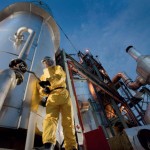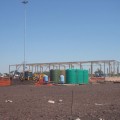South Africa’s Productivity Statistics for the year 2013 have been released, and they show a mixed bag of performances in various key industrial sectors of the economy.
The main economy sectors include construction, mining and quarrying, finance, insurance and real estate business, government services and agriculture, fishing and forestry.
In the agriculture, forestry and fisheries sector, there was an increase in the real output growth rate of 2.2% in 2013. The increase occurred despite a decrease in labour productivity growth rate of -6.8% in 2013.
Sectors that suffered a dip include electricity, gas and water. In 2012 and 2013, these sectors were under pressure and this was reflected in the productivity indicators.
The situation was underlined especially by the decline in the rate of capital (-9.4%), labour (-0.6%) and multifactor (-6.5%) productivity indicators.
The Chief Economist at Productivity SA, Keneuoe Mosoang, said the release of the stats was key in understanding how an improvement in productivity in the private and public sectors can help spur economic growth, with benefits such as job creation and improved service delivery from government.
“A few sectors of the economy have performed well, with the mining sector yielding a growth rate of 3.1% in 2013. The increase occurred despite a decrease in labour productivity growth rate of -6.8 percent in 2013,” Mosoang said.
Overall, a forecast for the 2013 data indicates that out of 20 manufacturing sub-sectors, seven sub sectors demonstrated declining productivity indicators (labour, capital and multifactor productivity) rates.
The sub-sectors under most duress were leather and leather products, food and rubber sub-sectors, which showed all three productivity indicators, including real output experiencing negative growth rates.
Fifty percent of the-sub sectors, which include glass and glass products, wood and wood products and printing, among others, showed positive growth rates in all three productivity indicators.
However, the only sub-sectors which showed improvement in output were printing, publishing and recorded media and basic chemicals.
“It is comforting that the motor vehicles, parts and accessories sub-sector, which has been the main driver of the manufacturing sector, still experienced positive growth, with productivity indicators still showing strong growth – even though the growth rates on investment, coupled with the return on investment, declined,” said Mosoang.
Shaping productivity
Labour Deputy Minister Nkosi Phathekile Holomisa welcomed the release of the statistics, saying they served as a window to indicate whether or not the country was productive.
“Most importantly, the statistics form our very own blueprint to highlight areas that need improvement to enable South Africa to meet its development goals,” he said.
The Deputy Minister said good leadership could not be divorced from good productivity levels.
“Good leaders are able to align goals throughout the organisation, making them visible from senior management right down to the shop floor.
“Staff members, who are aware of the company goals and objectives and understand their role in achieving the overall goals, will inevitably add more value to the business,” he said.
Deputy Minister Holomisa said effective communication was a characteristic of a good leader.
“Most businesses fail due to poor communication and a lack proper communication structures,” he said.
According to Productivity SA — government’s sole productivity agency responsible for encouraging and driving productivity in the public and private sector — there has been a steady growth in the country’s productivity and economy.
The mandate of Productivity SA is to enhance the productive capacity of all South Africans. – SAnews.gov.za








